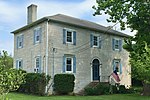Abbott Farm Historic District

The Abbott Farm Historic District is a National Historic Landmark archaeological site in New Jersey. It is the largest known Middle Woodland village of its type on the East Coast of the United States. Significant evidence suggests that the Delaware River floodplain was occupied by Paleoindian people for a long period. It was inhabited between 500 BC and 500 AD. It has been a source of controversy and debate around early development. The district encompasses some 2,000 acres (810 ha) of marshlands and bluffs in southern Mercer County and northern Burlington County, in the communities of Hamilton Township, Bordentown, and Bordentown Township. The John A. Roebling Memorial Park, part of the Abbott Marshlands, provides access to both historic sites and nature habitats in the area. The district was added to the National Register of Historic Places as the Abbott Farm Archeological Site on December 8, 1976 for its significance in prehistory and science.The importance of this site was established in the late 19th century by Charles Conrad Abbott, an archaeologist whose farm was located on one of the bluffs overlooking the marshlands. Abbott's finds on his farm, published in 1876, sparked a debate about when humans first arrived in the area, and consequently had significant influence on the direction of later archaeological work. Many finds from the site are at Harvard University's Peabody Museum of Archaeology and Ethnology, for which Abbott served as assistant curator for many years.
Excerpt from the Wikipedia article Abbott Farm Historic District (License: CC BY-SA 3.0, Authors, Images).Abbott Farm Historic District
Grover Avenue,
Geographical coordinates (GPS) Address Nearby Places Show on map
Geographical coordinates (GPS)
| Latitude | Longitude |
|---|---|
| N 40.175 ° | E -74.708333333333 ° |
Address
Grover Avenue
Grover Avenue
08610
New Jersey, United States
Open on Google Maps







